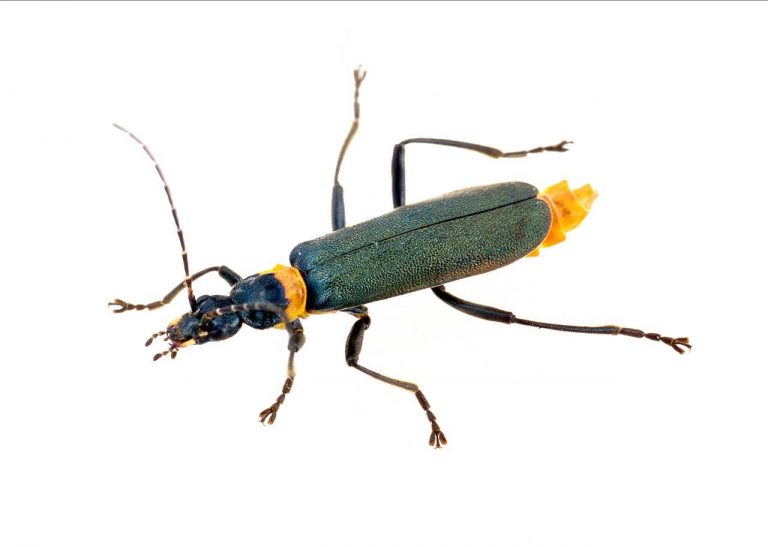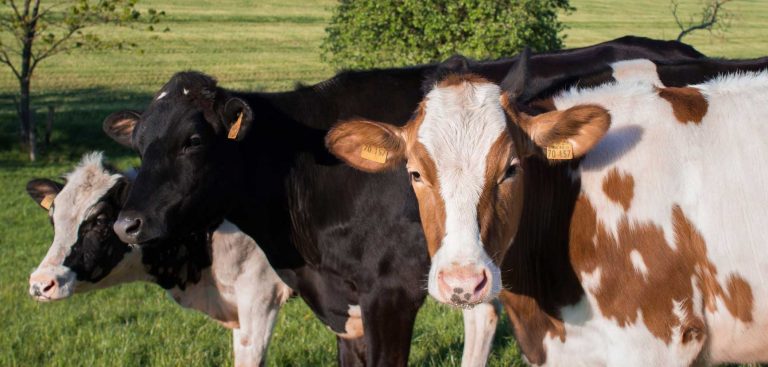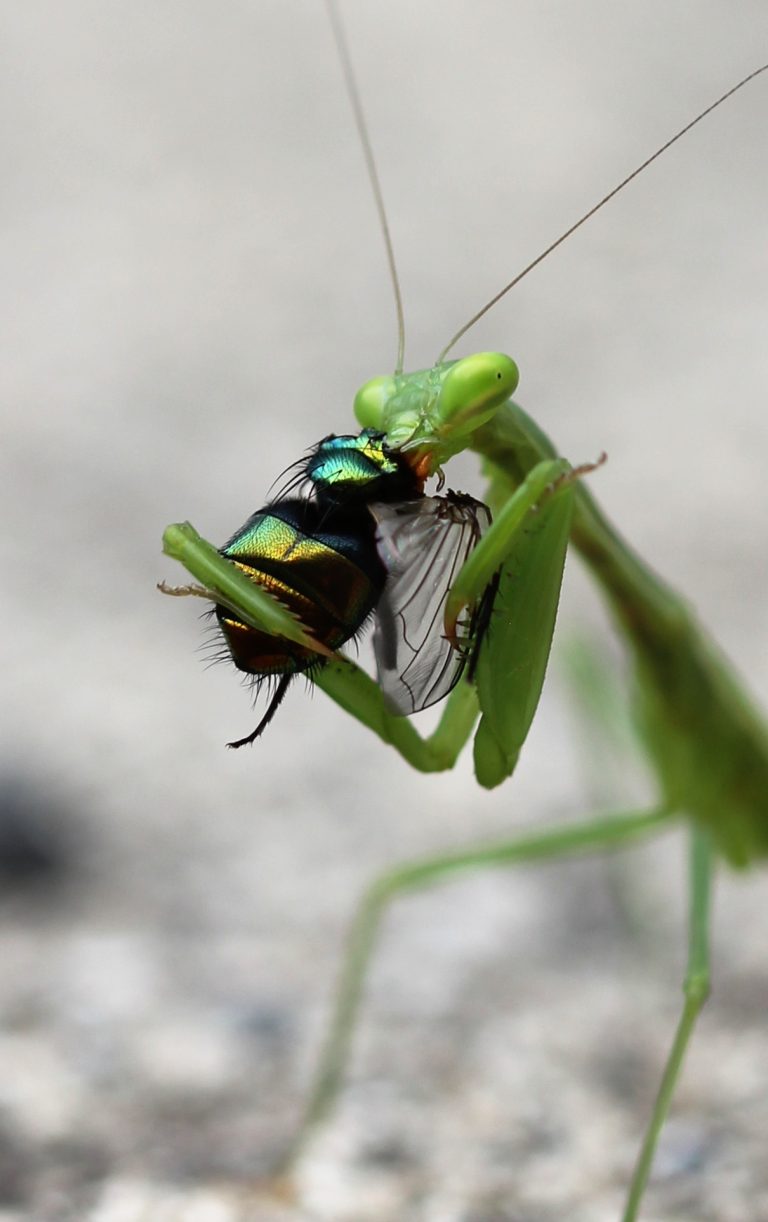Rove Beetle
Scientific Classification
| Kingdom: | Animalia |
| Phylum: | Arthropoda |
| Class: | Insecta |
| Order: | Coleoptera |
| Suborder: | Polyphaga |
| Infraorder: | Staphyliniformia |
| Superfamily: | Staphylinoidea |
| Family: | Staphylinidae |
The Rove beetles are a family (Staphylinidae) of beetles, primarily distinguished by their short elytra that leave more than half of their abdomen exposed. With approximately 58,000 species in thousands of genera, the group is currently recognized as the biggest beetle family. It is an ancient group, of fossil rove beetles known from the Triassic period, 200 million years ago, and possibly even earlier if the genus Leehermania proves to be a member of this family. They are an ecologically and morphologically diverse group of beetles, and commonly encountered in terrestrial ecosystems.
One well-known species is the Devil’s Coach Horse Beetle. For some other species, see List of British Rove Beetles.

Classification
Phylogeny: At present the four lines of pilots are (Newton and Lawrence 1995) comprised in Staphylinidae
- Minor groups: Microsilphinae, Glyohomatinae, Empelinae, Omalinae, Micropeplinae, Proteinnae, Dasycerinae, Eophoninae, Pselaphinae, Protopselapninae, and Scydmaeninae.
- Minority groups: Olisthaerinae, Phloeocharinae, Trichophyinae, Tachyporinae, Aleocharinae and Habrocerinae.
- Minority Group: Apateticinae, Trigonurinae, Piestinae, Scaphidinae, Oxytelinae and Osorinae.
- Minor group: Megalopsidinae, Oxyporinae, Euaesthetinae, Stenunae, Leptotyphlinae, Solierinae, Paederinae, Pseudopsinae and Staphylininae.
- Major Group: The previous Texas Brathinidae, presently a division of the sub group Omalinae, Empelidae, presently a division of Empelinae, Dasyceridae, presently a division of Silphidae, Glypholomatini, previously a tribe belonging to Silphidae; Pselaphidae, presently a division of Pselaphinae, Microsilphinae, previously, a division of Silphidae, Scaphidiidae, presently a division of Scaphidiinae of the previous authors are at present in Staphylinidae and Scydmaenidae, presently a division of Scydmaeninae
Anatomy
In this large family unit, it appears that there exists an appreciable difference in their species. They range in size from 1 to 35 mm (0.25 to 1.5 inches), The majority of them fall under the 2 to 8 mm range, Their structure is normally lengthened. Certain Rove Beetles do not have a definite structure. Their colors vary from yellow to brown with a red hue to brown with a black hue. Normally they have 11 segments and are Filiform (filament or threadlike), in the majority of genera; this clubbing is reasonable. The rove beetle”s abdomen is perhaps flexible and long, on the external appearance, they look like earwigs.
Certain Rove Beetles, affiliated to the Paederina, or a subordinate of Paederinae, possess a potent Vesicant (substance or agent) within their Haemolymph (Wikimedia – a fluid, analogous to the blood in vertebrates that circulate in the interior of the arthropod body remaining in direct contact with the animal’s tissues. It is composed of fluid plasma in which Hemolymph cells called Hemocytes are suspended), there is a chance for this Haemolymph to generate irritation to the skin, named dermatitis liners. In English language, this name is adversely misspelt as Paederus Dermatitis. This Pederin (a Vesicant toxic amide with two Tetrahydropyran rings) irritates, and is very poisonous, much more than that of the venom of a cobra.
Life Cycle
In Florida, there are much more than 600 types, but almost 530 of them are not in the record. (Frank 1986; Lundgren”s, revised list). The outlook and habitat of this big family differ to a great extent. Except for the little subordinate family unit, such as Oxyporinae, Micropeplinae and Leptotyphlinae and the bigger subordinate family unit such as Tachyporinae, there are complete, up to date taxonomic works permitting recognition of the whole Florida matured ones to the level of their species. Except for certain types of these Florida beetles, there exists a record of the explanation of the under developed stages, this is because their studies extended to diverse regions; and this accounts for the study of Staphylinidae as a fertile field. As for the inhabitants dynamics (Bionomics), there exist no records.
Feeding Behavior
The way of eating of the big family unit Staphylinidae, which comprises of other beetles of the Rove Genera are different according to the group to which they belong. The majority of the adult rove beetles and at the larva stage are voracious. They feed on several other tiny arthropods. The Rove beetles are seen as experts in their fungal spores diet. They mainly feed on the pollen and many on the regurgitated feed obtained from ants.
Reproduction
The breeding period is assumed as August to October. Statistics of the females that were dissected show that just 2 to 3 eggs were seen, they were oviposited (an insect depositing eggs) and solitary in the sand. For the sake of reproducing enough in number, these rove beetles generally survive for a long time. When in the laboratory, the eggs get hatched almost within 14 days. The color of the larvae has a white background with black marks. Their Instar period is not known.
As a Pest
When compared to the order of other species of insects, recently the number of types of Rove beetles has been seen to be much more. The present record shows that Staphylinidae is the biggest group of beetles, amounting to more than 54,000 of them known all over the world and perhaps, more than 75% of the species in the tropics that are not explained as yet. In America, North of Mexico, British Isles and in many other regions, a large number of varieties of these beetles are awaiting description. (It is hoped they are described prior to the team getting extinct, by destruction of their habitat).
Rove Beetle- Good or Bad
The Rove beetles can be considered both as good insects, mainly due to its feeding habits. It can help to control the harmful pupae and larvae of other species in the lawn or garden. Most of the them commonly eat all types of insects, but some specific type feed only on a particular type of insect, for instance, the Aleochara genus members feed on root maggots. But their emergence is too late to prevent the maggots from causing damage to the roots. In some places like Europe and Canada, the Rove beetles are bred to protect the important crops from pest damage. There is no need to take precautions or control methods against Rove beetles, as, after they eat up all the insects in your garden. After that, they will leave the place by themselves.
Amazing Facts About Rove Beetles
Though the Rove beetle has short elytra, it easily covers the functional hind wings set, which is not too short. Hence, they can still fly like the other beetles.
The number of Rove beetles may be more than the total number of all the vertebrates. Their family, the Stphyinidae alone is the biggest with more than 60,000 species, which is slightly less than the total number of vertebrates.
The Rove beetle species have a varied and colorful history, as it is present on the earth since the Jurassic era. The oldest Rove was discovered from the Triassic of Virginia, around 210 million years ago.
Like the variation in features, different types of Rove beetle belonging to distinct subfamilies exhibit variations in the morphological process. Whereas, few rare Rove beetle lineages have also remained unaffected to the changes in the morphology process. For instance, the Phloeocharis and Octavius genera have not undergone any changes in the morphology process for more than 90 million years. This phenomenon is termed as Bradytely.

Having discovered a fondness for insects while pursuing her degree in Biology, Randi Jones was quite bugged to know that people usually dismissed these little creatures as “creepy-crawlies”.







